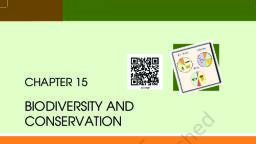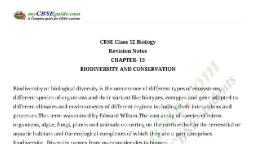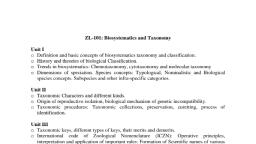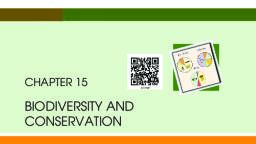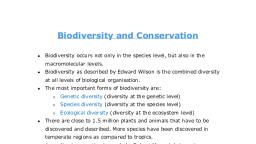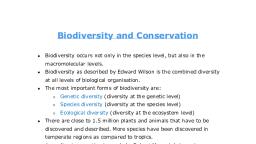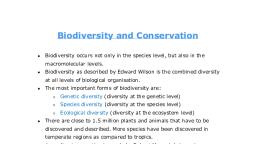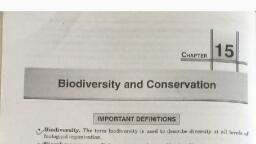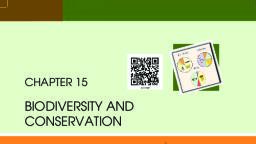Page 1 :
BIODIVERSITY AND, CONSERVATION, , , , 1, Biodiversity, , , , gw The occurrence of different ty i, y i < ypes of genes, gene pools, ies, habitats and ecosystems in a, particular place and various parts of earth is called biodiversity. . . ., ug The term ‘biodiversity’ was given by Edward Wilson., u Biodiversity is divided into three levels:, , (i) Genetic diversity, @ Itis the measure of variety in genetic information contained in the organisms., @ Itenables a population to adapt to its environment., e For example, medicinal plant Rawwolfia vomitoria growing in Himalayan ranges shows variation, in potency and concentration of the active chemical reserpine that it produces., © There are more than 50,000 genetically different strains of rice and 1,000 varieties of mango in, , India., , (ii) Species diversity, © Itis a measure of the variety of species and their relative abundance present within a region., , @ For example, the Western Ghats have a greater amphibian species diversity than the Eastern, , Ghats., , (iii) Ecological diversity, the diversity at community and ecos, , unique habitat and regional components of species diversity., @ Forexample, ecological diversity is greater in India due to presence of large number of ecosystems, , like deserts, rainforests, coral reefs, wetlands, estuaries and alpine meadows., , 2. Global Species Diversity —§——=—=—-______—____, , ernational Union for Conservation of Nature and natural resources or IUCN, , ber of plant and animal species is over 1.5 million., scientifically sound estimate made by Robert May, places the global species, , @ It is a measure of ystem levels. They represent the local,, , ® According to the Int, (2004), the total num!, @ A more conservative and, diversity at about 7 million., @ More than 70 per cent of all, the total., , m Amongst animals, insects co, planet, 7 are insects on this, , | the species are animals, while plants account for about 22 per cent of, , mprise more than 70 per cent that means, out of every 10 animals on this, , earth.
Page 2 :
Amphibians, , , , Angiosperms, , , , Algae Lichens, , , , , , , , Fig. 15.1 Global biodiversity representation: Proportionate number of species of, major taxa of plants, invertebrates and vertebrates., , 3. Patterns of Biodiversity, , ® Biodiversity is not uniform throughout the, gradients and species-area relationship., , ee, , world because it is affected by two factors— latitudinal, , , , () Latitudinal gradients, , © Biodiversity increases from poles to equators, i.e., from high to low latitude., , © Tropics (23.5°N to 23.5°S) have more species th, Columbia located near the equator has 1,400 species of birds while New York (41.5°N) has 105, species and Greenland (71°N) has only 56 species., , © Tropical rain forests of Amazon in, with more than 40,000 speci, 427 of amphibian, , , , ‘an temperate or polar regions. For example,, , South America possess the greatest biodiversity on earth, of plants, 3,000 of fishes 1,300 birds, 427 of mammals,, , 378 of reptiles and more than 1,25,000 inverteb: tes., ® Greater biological div, , , , , , , , , ersity is observed in tropics because, (a) Temperate regions have been subjected to frequent glaciations in the past but tropical, , regions remained undisturbed, Therefore, tropics had a longer evolutionary time for, Species diversification,, , (b) Temperate environment, unpredictable, resulting, , (c) Tropics have greater sol, greater diversity,, , , , , , , , unlike the wopics are more seasonal, less constant and, in less niche specialisation and lesser species diversity., , ‘ar energy exposure which contributes to higher productivity and
Page 3 :
) species-area relationship, , @ German naturalist and, ‘Alexander von Humboldt o, within a region, species richn, with increasing explored are;, limit., , @ The relationship between species richness, and area for a wide variety of taxa (like, vascular plants, birds, bats and freshwater, fishes) appears as a rectangular hyperbola, , Ona logarithmic scale, the relatio, :, a straight line described by the, equation:, , v S=CAe, , , , Seographer, bserved that, ess increased, ‘a but up toa, , Log $= log C + ZlogA, , Species richness. ——>, , nship is, following, , , , Area. ——>, , log S = log C + Zlog A, where S = Species richness, A= Area, , , , Fig. 15.2 Species-area relationship: On log scale the, relationship becomes linear, , Z = Slope of the line (regression coefficient), C = ¥.intercept., , @ The value of Z lies in the range of 0.1-0.2 regardless of taxonomic group or the region., , @ However, the analysis in a very large area like the whole continent gives a Z value that ranges, from 0.6 to 1.2., , 4. Importance of Species Diversity to the Ecosystem, , , , @ Ecologists believe that communities with more species tend to be more stable than those with less, species. This was confirmed by David Tilman., , @ Characteristics of a stable community:, (i) Productivity should not vary too much from year to year., , (i) It should be resistant to occasional natural and man-made disturbances., (ii) It should be resistant to invasions by alien species., , 8 Importance of biodiversity for survival of species can be explained by the ‘rivet popper hypothesis’, proposed by Paul Ehrlich., , @ This hypothesis assumes the ecosystem to be an airplane and the species to be the rivets joining all, parts together., , @ Ifevery passenger pops a rivet to take home (resulting in species extinction), it may not affect the, flight safety initially (proper ecosystem functioning) but with time as more rivets are removed the, plane becomes dangerously weak and fatal to the life of other species., , 5. Loss of Biodiversity, , , , anisation and industrialisation., , ® It is caused by over-population, urb:, slands by humans has led to the extinction of more than 2,000, , ®@ The colonisation of tropical Pacific I, species of native birds. ;, , @ 15,500 species are facing the threat of extinction worldwide. 7, , @ At present, 31 per cent of gymnosperms, 32 per cent of amphibians, 12 per cent of bird species and, 23 per cent of mammals face the threat of extinction., , pecies are dodo (Mauritius), quagga (Africa), thylacine (Australia), Stellar’s, , ® Some recently extinct s t :, i es (Bali, Java, Caspian)., , sea cow (Russia) and three tiger speci
Page 4 :
a Loss of biodiversity in a region may lead to, , j i ¢ production., (@ decrease in plan /, (ii) less resistance to environmental disturbances such as enous 3, (iii) increased variability in ecosystem processes like plant productivity, water use, pest and disease, , cycles., , 6. Causes of Biodiversity Losses, , mg There are four major causes of biodiversity loss. These are also known as “The Evil Quartet’,, , (i) Habitat loss and fragmentation :, © Destruction of habitat is the primary cause of extinction of species., , © The tropical rainforests initially covered 14 per cent of the land surface of earth, but now cover, , only 6 per cent of land area., , @ The Amazon rainforest (called the t”), of soya beans and for conversion into grasslands for raising beef cattle. |, , @ When large-sized habitats are broken or fragmented due to human settlements, building of, roads, digging of canals, etc., the population of animals requiring large territories and some, , animals with migratory habitats declines., , “Jungs of the planet”) is being cut and cleared for cultivation, , (ii) Over-exploitation, , © When biological system is over-exploited by man for the natural resources, it results in, degradation and extinction of the resources., , © For example, Stellar’s sea cow, passenger pigeon and many marine fishes, , , , (iii) Alien (exotic) species invasions, , © Some alien (exotic) species when introduced unintentionally or deliberately, become invasive, and cause harmful impact, resulting in extinction of the indigenous species., , © Nile perch, a large predator fish when introduced in Lake Victoria (East Africa) caused the, extinction of an ecologically unique species of Cichlid fish in the lake., , © Invasive weed species like Parthenium (carrot grass), Lantana and Eichhornia (water hyacinth), caused environmental damage and posed threat to our native species., , @ Introduction of African catfish (Clarias gariepinus) for aquaculture purposes is posing a threat to, the indigenous cat fishes of Indian rivers., , (iv) Co-extinctions, @ When a species becomes extinct, the plant and animal species associated with it in an obligatory, manner, also become extinct., © For example, if the host fish species becomes extinct, all those parasites exclusively dependent, on it, will also become extinct; in plant-pollinator mutualism also, extinction of one results in, the extinction of the other., , 7. Reasons for Biodiversity Conservation, tame : ‘ ‘Diodiversity-alliii iiave een clusuied into the, oleae reasons for conserving the biodiversity which have been classified into the, , (i) Narrowly utilitarian arguments, , @ Human bei i 5, ings derive direct economic benefits from nature, like food, firewood, fibre,, , construction material, industri, Fe , industri is i a, important products, ial products (resins, gums, dyes, tannins, etc.) and medicinally, , © More than 25 per cent of th, , are used by native people ie drugs are derived from plants and about 25,000 species of plants, , traditional medicines.
Page 5 :
eC) we eAININ tee, vaners species as well as ecological systems 8 and Sustaining supply of goods and services, @ The different ecological Services provided, (@) Amazon forest is estimated t are:, , (b) Ecosystem provides pollinators };, form fruits and seeds. ts like bees, bumble bees, , (c) Aesthetic pleasures like bir, forest, waking up to a bulb, , © contribute, 20 per cent of the total oxygen in the atmosphe, , » birds and bats which pollinate pla, , d watchi : oe, al’s ching, spring flowers in full bloom, walking through the, Song, etc. are some other bene, , ba fits of the ecosystem., ) Ethical reasons, , =, , @ Itis, therefore, our moral duty to en :, : sure well- Fast ss,, of future generations, being of all the living creatures for the utili:, , 8. Conservation of Biodiversity, , ® Biodiversity can be conserved by protecting its whole ecosystem., g There are two basic approaches for conservation of biodiversity., , , , Biodiversity Conservation, , i, In situ conservation |, recep, , , , , , , , ieee, , Biodiversity hot spots, , Biosphere National wi, 4 Teserves Parks, , , , , Protection of, gametes, , , , , , threatened species, , , , , , , , , , , , , , Sn Ma, a, , , , , ©, fe Sacred Zoological Botanical d, sanctuaries groves parks gardens safari park, , , , , , , , , , , Loree, ‘ Tissue Seed _ Gene, se culture banks

